Business Report: Analyzing Cultural Differences in Leadership
VerifiedAdded on 2022/08/12
|16
|3572
|420
Report
AI Summary
This business report examines cultural differences in leadership, emphasizing their importance in a global business environment. The report begins by defining leadership and highlighting the significance of cross-cultural competency, essential for professional excellence. It delves into the impact of cultural differences on leadership styles, including autocratic, bureaucratic, charismatic, and democratic approaches, illustrating how these styles vary across cultures. The report identifies factors linked to leadership effectiveness, such as communication, decision-making, and time management, and discusses how these are influenced by cultural nuances. It explores how cultural differences can be leveraged to improve leadership efficiencies, emphasizing the importance of knowledge, self-awareness, and application in a cross-cultural setting. The report provides actionable recommendations for maximizing the benefits of a culturally diverse team, concluding with a call to understand and embrace cultural differences for global business success. The report follows APA style with numerous citations and references.

Running head: LEADERSHIP
Leadership
Name of Student
Name of University
Author Note
Leadership
Name of Student
Name of University
Author Note
Paraphrase This Document
Need a fresh take? Get an instant paraphrase of this document with our AI Paraphraser
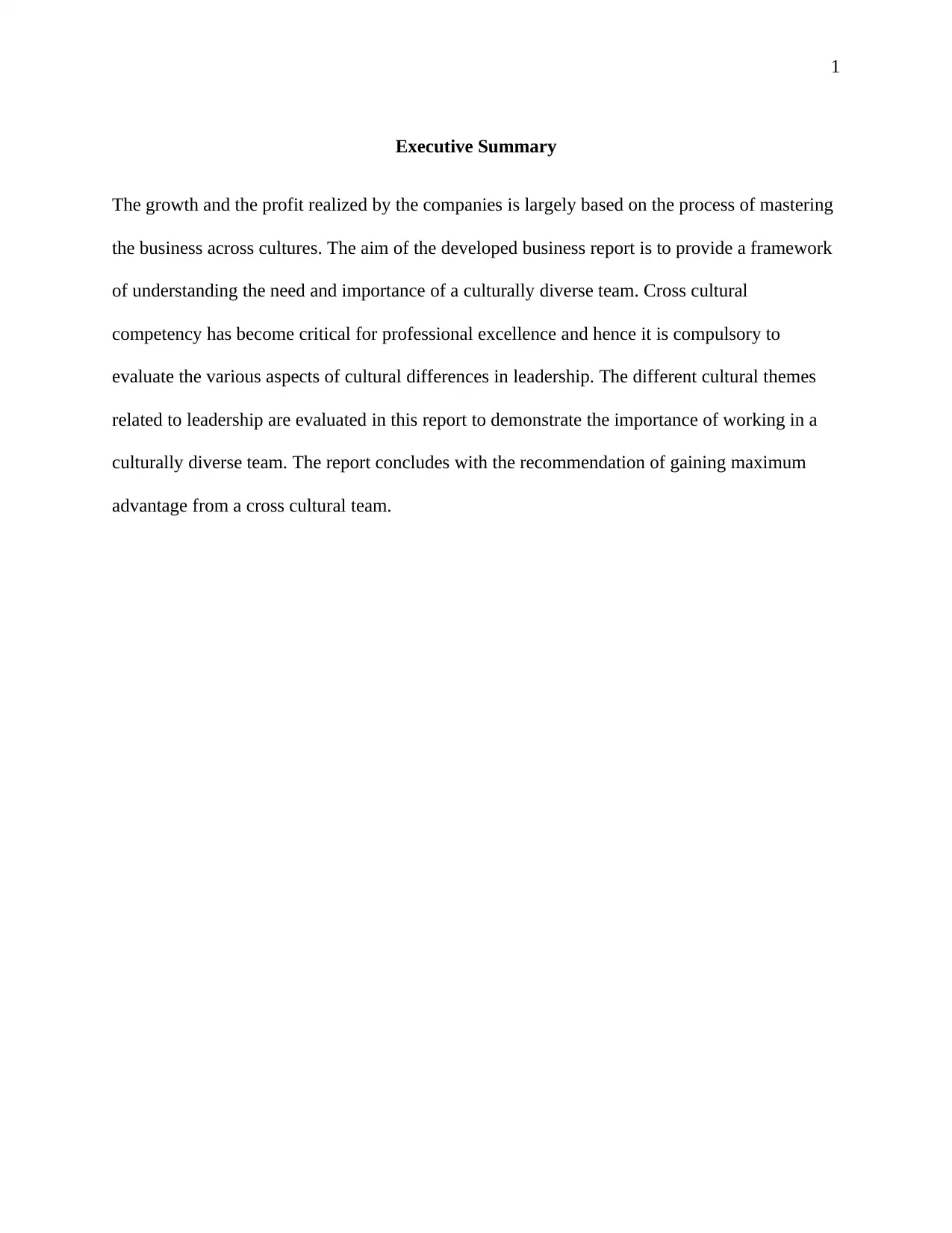
1
Executive Summary
The growth and the profit realized by the companies is largely based on the process of mastering
the business across cultures. The aim of the developed business report is to provide a framework
of understanding the need and importance of a culturally diverse team. Cross cultural
competency has become critical for professional excellence and hence it is compulsory to
evaluate the various aspects of cultural differences in leadership. The different cultural themes
related to leadership are evaluated in this report to demonstrate the importance of working in a
culturally diverse team. The report concludes with the recommendation of gaining maximum
advantage from a cross cultural team.
Executive Summary
The growth and the profit realized by the companies is largely based on the process of mastering
the business across cultures. The aim of the developed business report is to provide a framework
of understanding the need and importance of a culturally diverse team. Cross cultural
competency has become critical for professional excellence and hence it is compulsory to
evaluate the various aspects of cultural differences in leadership. The different cultural themes
related to leadership are evaluated in this report to demonstrate the importance of working in a
culturally diverse team. The report concludes with the recommendation of gaining maximum
advantage from a cross cultural team.
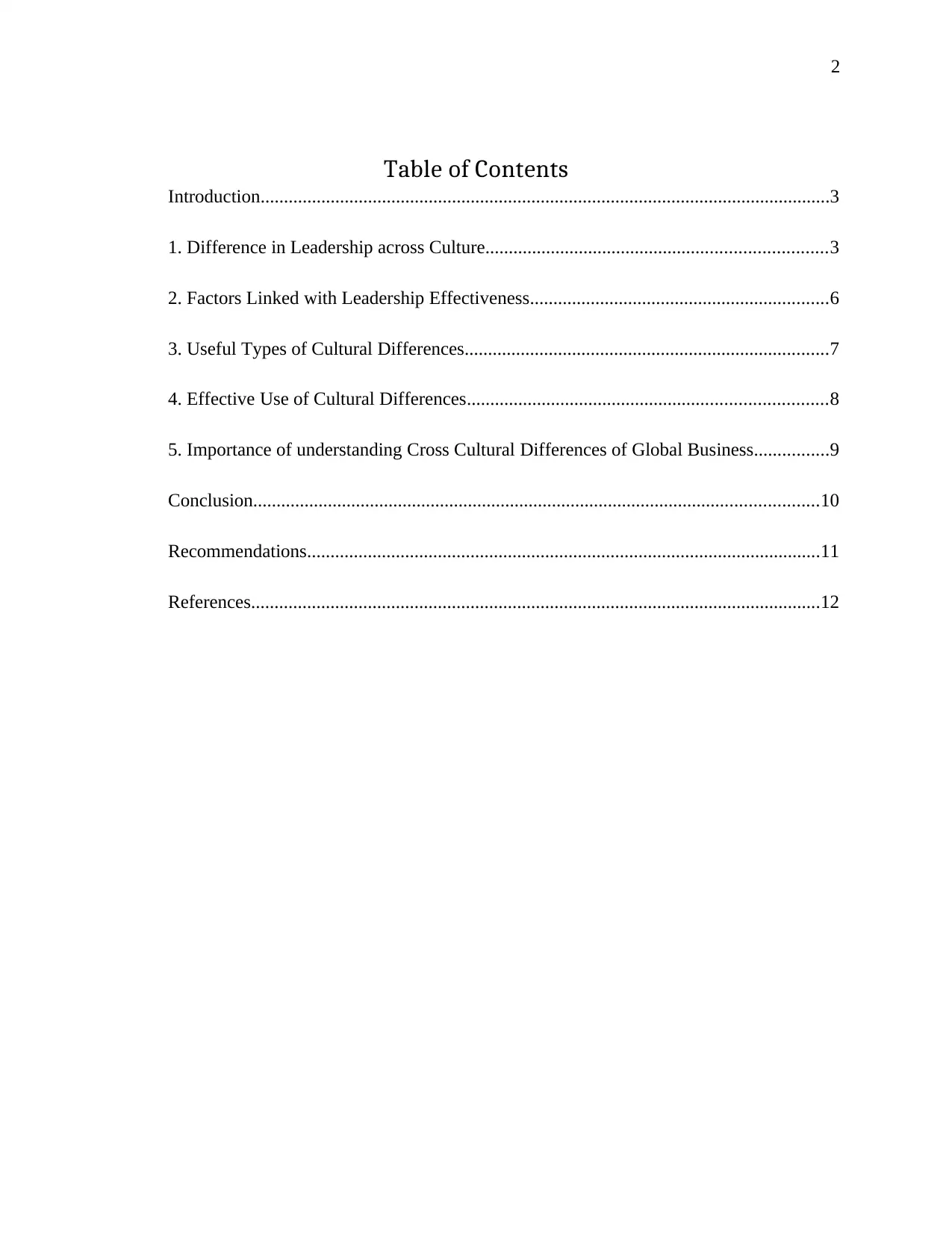
2
Table of Contents
Introduction..........................................................................................................................3
1. Difference in Leadership across Culture.........................................................................3
2. Factors Linked with Leadership Effectiveness................................................................6
3. Useful Types of Cultural Differences..............................................................................7
4. Effective Use of Cultural Differences.............................................................................8
5. Importance of understanding Cross Cultural Differences of Global Business................9
Conclusion.........................................................................................................................10
Recommendations..............................................................................................................11
References..........................................................................................................................12
Table of Contents
Introduction..........................................................................................................................3
1. Difference in Leadership across Culture.........................................................................3
2. Factors Linked with Leadership Effectiveness................................................................6
3. Useful Types of Cultural Differences..............................................................................7
4. Effective Use of Cultural Differences.............................................................................8
5. Importance of understanding Cross Cultural Differences of Global Business................9
Conclusion.........................................................................................................................10
Recommendations..............................................................................................................11
References..........................................................................................................................12
⊘ This is a preview!⊘
Do you want full access?
Subscribe today to unlock all pages.

Trusted by 1+ million students worldwide
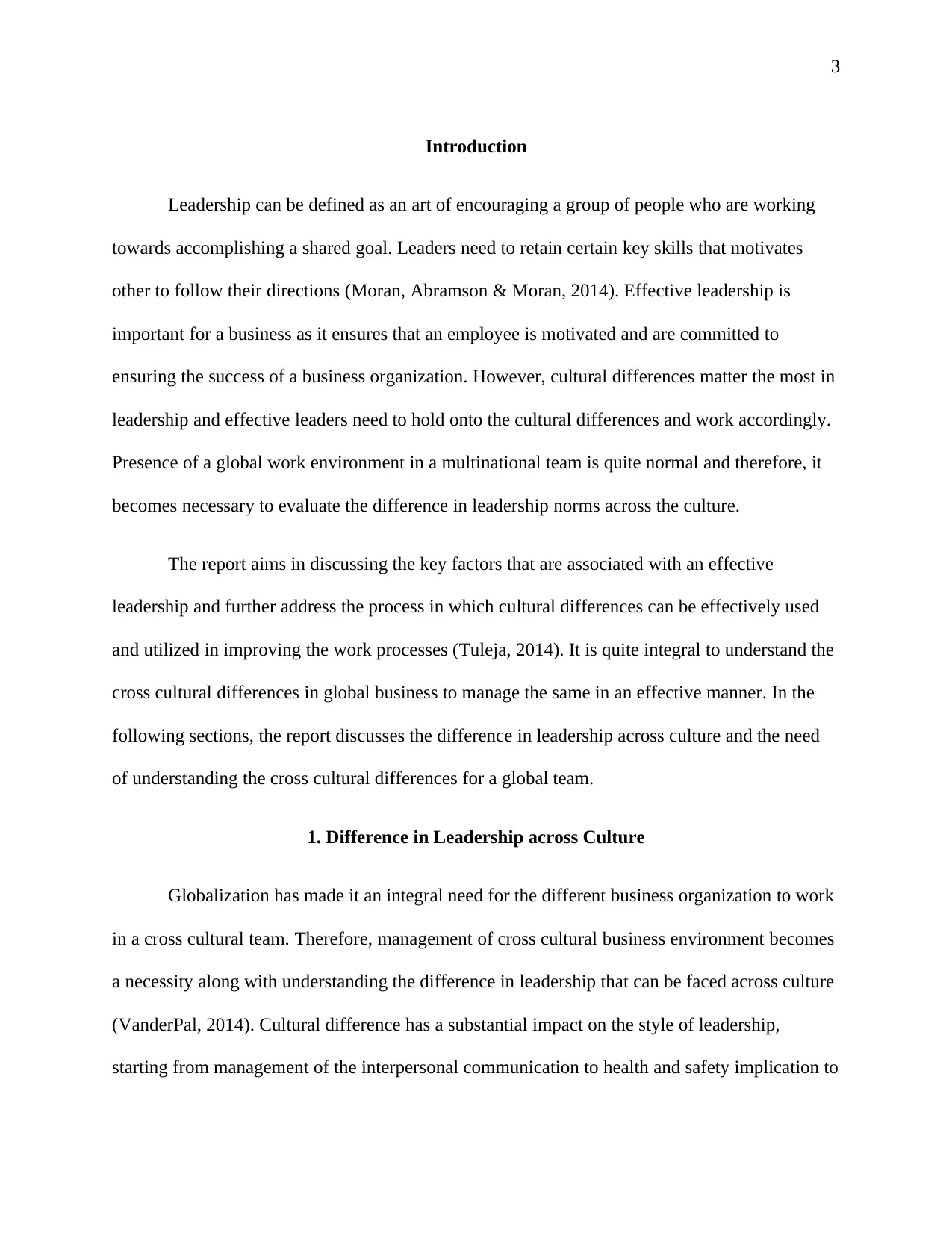
3
Introduction
Leadership can be defined as an art of encouraging a group of people who are working
towards accomplishing a shared goal. Leaders need to retain certain key skills that motivates
other to follow their directions (Moran, Abramson & Moran, 2014). Effective leadership is
important for a business as it ensures that an employee is motivated and are committed to
ensuring the success of a business organization. However, cultural differences matter the most in
leadership and effective leaders need to hold onto the cultural differences and work accordingly.
Presence of a global work environment in a multinational team is quite normal and therefore, it
becomes necessary to evaluate the difference in leadership norms across the culture.
The report aims in discussing the key factors that are associated with an effective
leadership and further address the process in which cultural differences can be effectively used
and utilized in improving the work processes (Tuleja, 2014). It is quite integral to understand the
cross cultural differences in global business to manage the same in an effective manner. In the
following sections, the report discusses the difference in leadership across culture and the need
of understanding the cross cultural differences for a global team.
1. Difference in Leadership across Culture
Globalization has made it an integral need for the different business organization to work
in a cross cultural team. Therefore, management of cross cultural business environment becomes
a necessity along with understanding the difference in leadership that can be faced across culture
(VanderPal, 2014). Cultural difference has a substantial impact on the style of leadership,
starting from management of the interpersonal communication to health and safety implication to
Introduction
Leadership can be defined as an art of encouraging a group of people who are working
towards accomplishing a shared goal. Leaders need to retain certain key skills that motivates
other to follow their directions (Moran, Abramson & Moran, 2014). Effective leadership is
important for a business as it ensures that an employee is motivated and are committed to
ensuring the success of a business organization. However, cultural differences matter the most in
leadership and effective leaders need to hold onto the cultural differences and work accordingly.
Presence of a global work environment in a multinational team is quite normal and therefore, it
becomes necessary to evaluate the difference in leadership norms across the culture.
The report aims in discussing the key factors that are associated with an effective
leadership and further address the process in which cultural differences can be effectively used
and utilized in improving the work processes (Tuleja, 2014). It is quite integral to understand the
cross cultural differences in global business to manage the same in an effective manner. In the
following sections, the report discusses the difference in leadership across culture and the need
of understanding the cross cultural differences for a global team.
1. Difference in Leadership across Culture
Globalization has made it an integral need for the different business organization to work
in a cross cultural team. Therefore, management of cross cultural business environment becomes
a necessity along with understanding the difference in leadership that can be faced across culture
(VanderPal, 2014). Cultural difference has a substantial impact on the style of leadership,
starting from management of the interpersonal communication to health and safety implication to
Paraphrase This Document
Need a fresh take? Get an instant paraphrase of this document with our AI Paraphraser
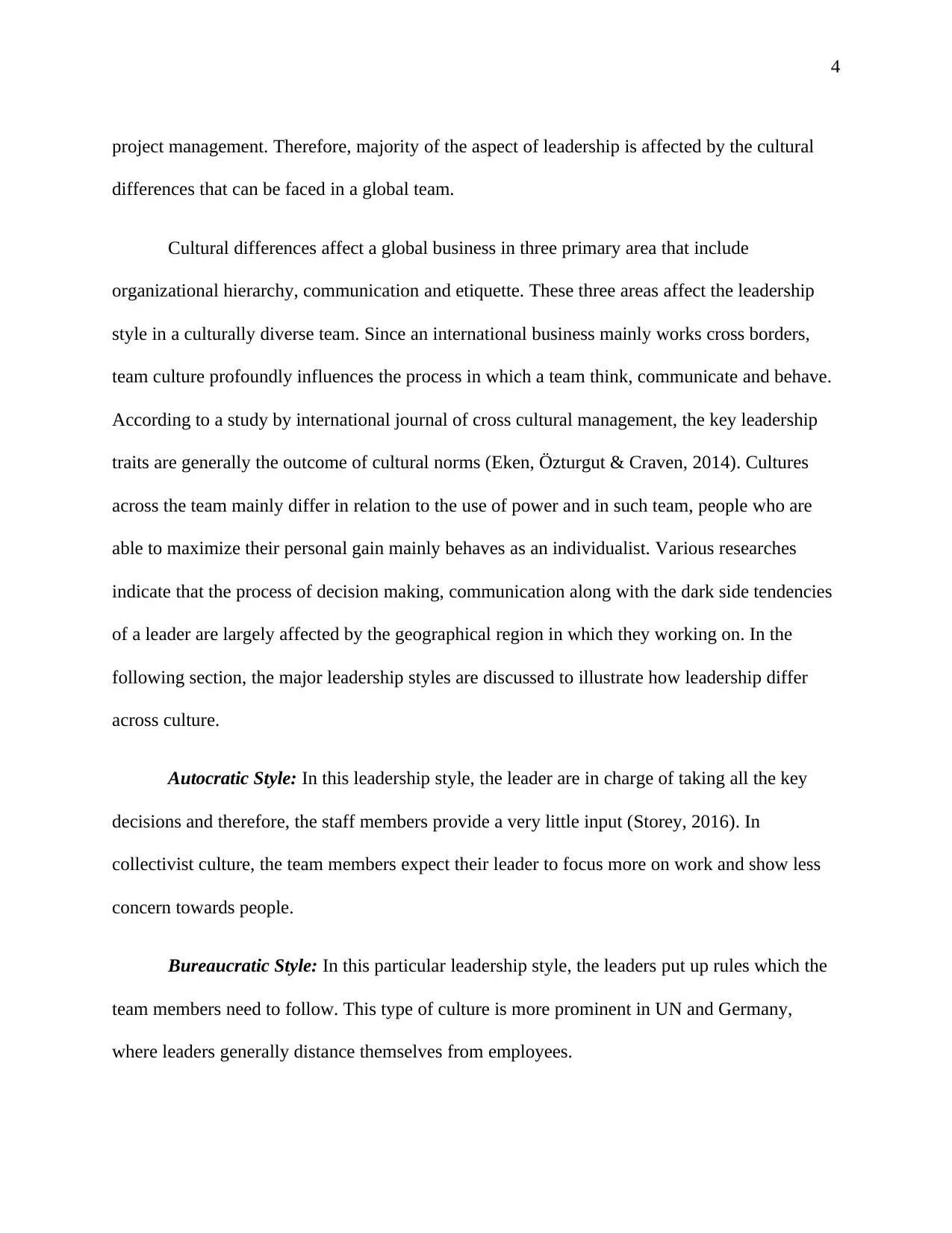
4
project management. Therefore, majority of the aspect of leadership is affected by the cultural
differences that can be faced in a global team.
Cultural differences affect a global business in three primary area that include
organizational hierarchy, communication and etiquette. These three areas affect the leadership
style in a culturally diverse team. Since an international business mainly works cross borders,
team culture profoundly influences the process in which a team think, communicate and behave.
According to a study by international journal of cross cultural management, the key leadership
traits are generally the outcome of cultural norms (Eken, Özturgut & Craven, 2014). Cultures
across the team mainly differ in relation to the use of power and in such team, people who are
able to maximize their personal gain mainly behaves as an individualist. Various researches
indicate that the process of decision making, communication along with the dark side tendencies
of a leader are largely affected by the geographical region in which they working on. In the
following section, the major leadership styles are discussed to illustrate how leadership differ
across culture.
Autocratic Style: In this leadership style, the leader are in charge of taking all the key
decisions and therefore, the staff members provide a very little input (Storey, 2016). In
collectivist culture, the team members expect their leader to focus more on work and show less
concern towards people.
Bureaucratic Style: In this particular leadership style, the leaders put up rules which the
team members need to follow. This type of culture is more prominent in UN and Germany,
where leaders generally distance themselves from employees.
project management. Therefore, majority of the aspect of leadership is affected by the cultural
differences that can be faced in a global team.
Cultural differences affect a global business in three primary area that include
organizational hierarchy, communication and etiquette. These three areas affect the leadership
style in a culturally diverse team. Since an international business mainly works cross borders,
team culture profoundly influences the process in which a team think, communicate and behave.
According to a study by international journal of cross cultural management, the key leadership
traits are generally the outcome of cultural norms (Eken, Özturgut & Craven, 2014). Cultures
across the team mainly differ in relation to the use of power and in such team, people who are
able to maximize their personal gain mainly behaves as an individualist. Various researches
indicate that the process of decision making, communication along with the dark side tendencies
of a leader are largely affected by the geographical region in which they working on. In the
following section, the major leadership styles are discussed to illustrate how leadership differ
across culture.
Autocratic Style: In this leadership style, the leader are in charge of taking all the key
decisions and therefore, the staff members provide a very little input (Storey, 2016). In
collectivist culture, the team members expect their leader to focus more on work and show less
concern towards people.
Bureaucratic Style: In this particular leadership style, the leaders put up rules which the
team members need to follow. This type of culture is more prominent in UN and Germany,
where leaders generally distance themselves from employees.
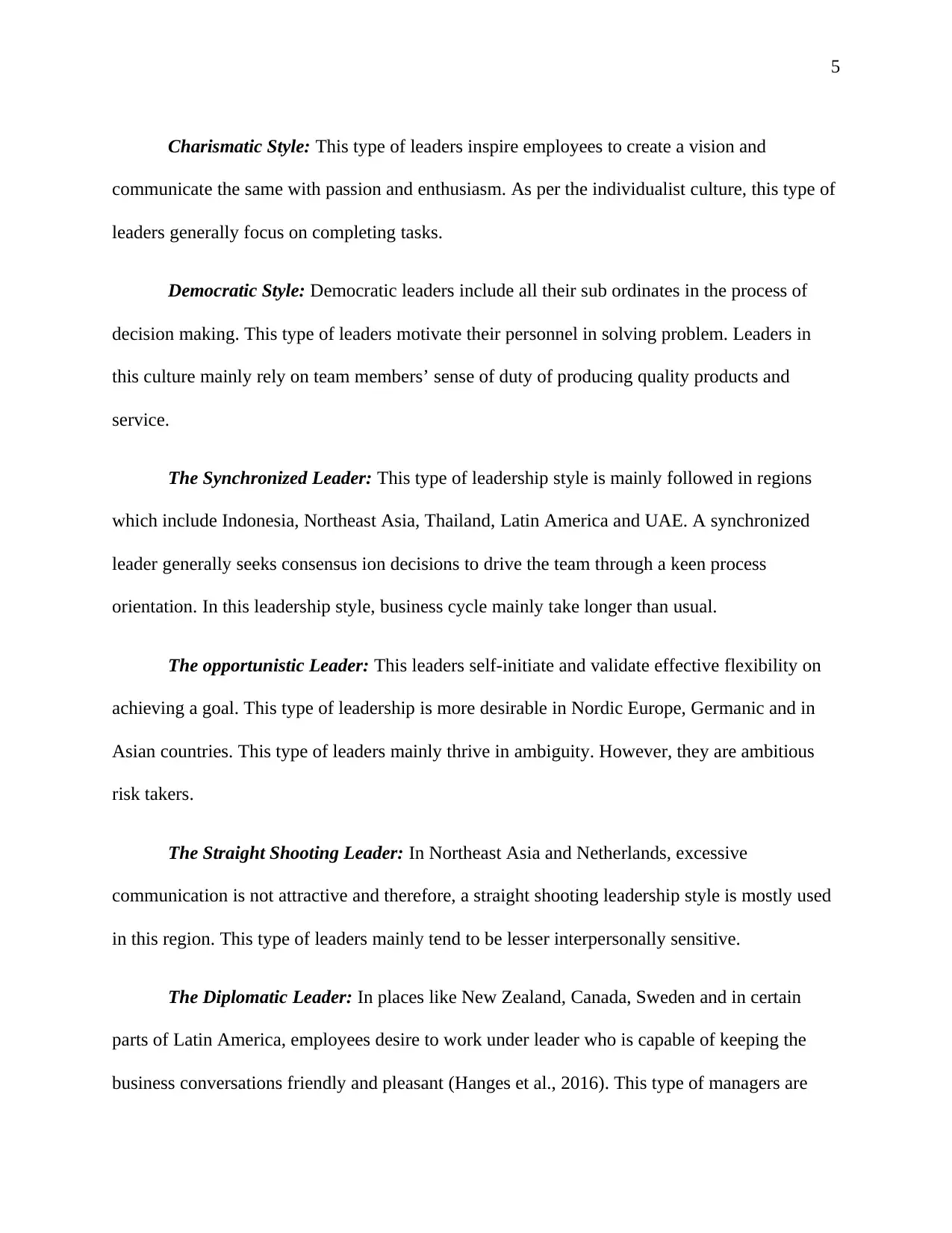
5
Charismatic Style: This type of leaders inspire employees to create a vision and
communicate the same with passion and enthusiasm. As per the individualist culture, this type of
leaders generally focus on completing tasks.
Democratic Style: Democratic leaders include all their sub ordinates in the process of
decision making. This type of leaders motivate their personnel in solving problem. Leaders in
this culture mainly rely on team members’ sense of duty of producing quality products and
service.
The Synchronized Leader: This type of leadership style is mainly followed in regions
which include Indonesia, Northeast Asia, Thailand, Latin America and UAE. A synchronized
leader generally seeks consensus ion decisions to drive the team through a keen process
orientation. In this leadership style, business cycle mainly take longer than usual.
The opportunistic Leader: This leaders self-initiate and validate effective flexibility on
achieving a goal. This type of leadership is more desirable in Nordic Europe, Germanic and in
Asian countries. This type of leaders mainly thrive in ambiguity. However, they are ambitious
risk takers.
The Straight Shooting Leader: In Northeast Asia and Netherlands, excessive
communication is not attractive and therefore, a straight shooting leadership style is mostly used
in this region. This type of leaders mainly tend to be lesser interpersonally sensitive.
The Diplomatic Leader: In places like New Zealand, Canada, Sweden and in certain
parts of Latin America, employees desire to work under leader who is capable of keeping the
business conversations friendly and pleasant (Hanges et al., 2016). This type of managers are
Charismatic Style: This type of leaders inspire employees to create a vision and
communicate the same with passion and enthusiasm. As per the individualist culture, this type of
leaders generally focus on completing tasks.
Democratic Style: Democratic leaders include all their sub ordinates in the process of
decision making. This type of leaders motivate their personnel in solving problem. Leaders in
this culture mainly rely on team members’ sense of duty of producing quality products and
service.
The Synchronized Leader: This type of leadership style is mainly followed in regions
which include Indonesia, Northeast Asia, Thailand, Latin America and UAE. A synchronized
leader generally seeks consensus ion decisions to drive the team through a keen process
orientation. In this leadership style, business cycle mainly take longer than usual.
The opportunistic Leader: This leaders self-initiate and validate effective flexibility on
achieving a goal. This type of leadership is more desirable in Nordic Europe, Germanic and in
Asian countries. This type of leaders mainly thrive in ambiguity. However, they are ambitious
risk takers.
The Straight Shooting Leader: In Northeast Asia and Netherlands, excessive
communication is not attractive and therefore, a straight shooting leadership style is mostly used
in this region. This type of leaders mainly tend to be lesser interpersonally sensitive.
The Diplomatic Leader: In places like New Zealand, Canada, Sweden and in certain
parts of Latin America, employees desire to work under leader who is capable of keeping the
business conversations friendly and pleasant (Hanges et al., 2016). This type of managers are
⊘ This is a preview!⊘
Do you want full access?
Subscribe today to unlock all pages.

Trusted by 1+ million students worldwide
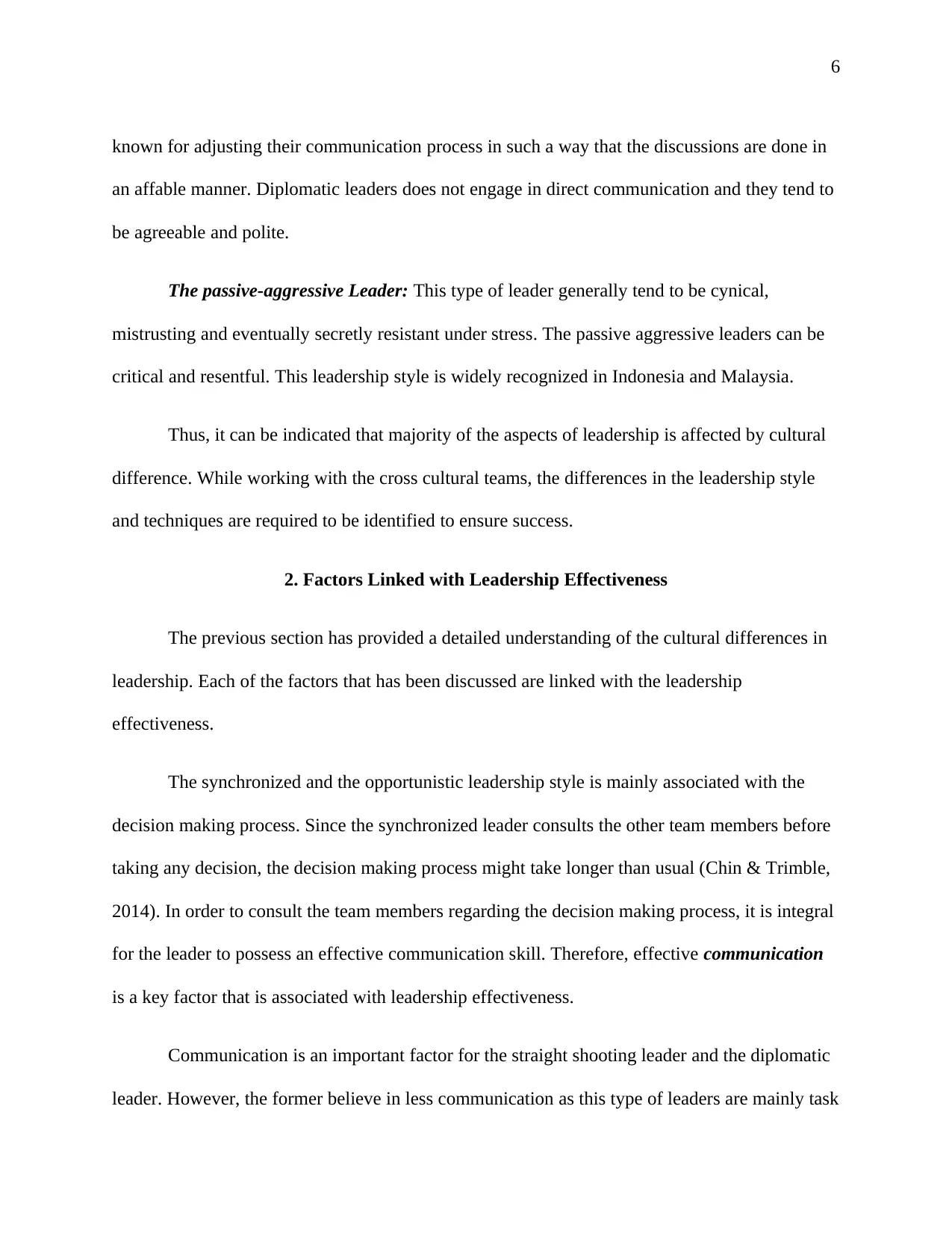
6
known for adjusting their communication process in such a way that the discussions are done in
an affable manner. Diplomatic leaders does not engage in direct communication and they tend to
be agreeable and polite.
The passive-aggressive Leader: This type of leader generally tend to be cynical,
mistrusting and eventually secretly resistant under stress. The passive aggressive leaders can be
critical and resentful. This leadership style is widely recognized in Indonesia and Malaysia.
Thus, it can be indicated that majority of the aspects of leadership is affected by cultural
difference. While working with the cross cultural teams, the differences in the leadership style
and techniques are required to be identified to ensure success.
2. Factors Linked with Leadership Effectiveness
The previous section has provided a detailed understanding of the cultural differences in
leadership. Each of the factors that has been discussed are linked with the leadership
effectiveness.
The synchronized and the opportunistic leadership style is mainly associated with the
decision making process. Since the synchronized leader consults the other team members before
taking any decision, the decision making process might take longer than usual (Chin & Trimble,
2014). In order to consult the team members regarding the decision making process, it is integral
for the leader to possess an effective communication skill. Therefore, effective communication
is a key factor that is associated with leadership effectiveness.
Communication is an important factor for the straight shooting leader and the diplomatic
leader. However, the former believe in less communication as this type of leaders are mainly task
known for adjusting their communication process in such a way that the discussions are done in
an affable manner. Diplomatic leaders does not engage in direct communication and they tend to
be agreeable and polite.
The passive-aggressive Leader: This type of leader generally tend to be cynical,
mistrusting and eventually secretly resistant under stress. The passive aggressive leaders can be
critical and resentful. This leadership style is widely recognized in Indonesia and Malaysia.
Thus, it can be indicated that majority of the aspects of leadership is affected by cultural
difference. While working with the cross cultural teams, the differences in the leadership style
and techniques are required to be identified to ensure success.
2. Factors Linked with Leadership Effectiveness
The previous section has provided a detailed understanding of the cultural differences in
leadership. Each of the factors that has been discussed are linked with the leadership
effectiveness.
The synchronized and the opportunistic leadership style is mainly associated with the
decision making process. Since the synchronized leader consults the other team members before
taking any decision, the decision making process might take longer than usual (Chin & Trimble,
2014). In order to consult the team members regarding the decision making process, it is integral
for the leader to possess an effective communication skill. Therefore, effective communication
is a key factor that is associated with leadership effectiveness.
Communication is an important factor for the straight shooting leader and the diplomatic
leader. However, the former believe in less communication as this type of leaders are mainly task
Paraphrase This Document
Need a fresh take? Get an instant paraphrase of this document with our AI Paraphraser

7
oriented (Thomas & Peterson, 2016). While in diplomatic leadership style careful
communication is promoted.
Thus, it can be said that communication and decision making are two most prominent
factors that are linked with cross cultural leadership.
Apart from that, there are certain key factors that affect the leadership styles across the
globe. This include interpersonal skills, sharing information, ability of team work and employee
motivation along with problem solving. An effective leader, needs to understand the importance
of time management to ensure that all works are executed on time. To summarize, the main
factors that are associated with the effectiveness of a leader include effective decision making,
time management, communication skill, skills of employee motivation, ability of managing a
team and motivating an employee (Tröster, Mehra & van Knippenberg, 2014). Each leader
across the globe need to possess these key qualities to ensure that the project team are working as
per the expectation.
3. Useful Types of Cultural Differences
The cultural differences affects leadership style across globe. In the previous sections, the
different types of leadership types are discussed. Certain cultural differences can positively affect
the leadership styles (Popescu et al. 2014). In certain culture, people tend to be group oriented
that helps in developing an effective group. In this culture, people mainly consider common goal
which further helps in improving the leadership process.
oriented (Thomas & Peterson, 2016). While in diplomatic leadership style careful
communication is promoted.
Thus, it can be said that communication and decision making are two most prominent
factors that are linked with cross cultural leadership.
Apart from that, there are certain key factors that affect the leadership styles across the
globe. This include interpersonal skills, sharing information, ability of team work and employee
motivation along with problem solving. An effective leader, needs to understand the importance
of time management to ensure that all works are executed on time. To summarize, the main
factors that are associated with the effectiveness of a leader include effective decision making,
time management, communication skill, skills of employee motivation, ability of managing a
team and motivating an employee (Tröster, Mehra & van Knippenberg, 2014). Each leader
across the globe need to possess these key qualities to ensure that the project team are working as
per the expectation.
3. Useful Types of Cultural Differences
The cultural differences affects leadership style across globe. In the previous sections, the
different types of leadership types are discussed. Certain cultural differences can positively affect
the leadership styles (Popescu et al. 2014). In certain culture, people tend to be group oriented
that helps in developing an effective group. In this culture, people mainly consider common goal
which further helps in improving the leadership process.
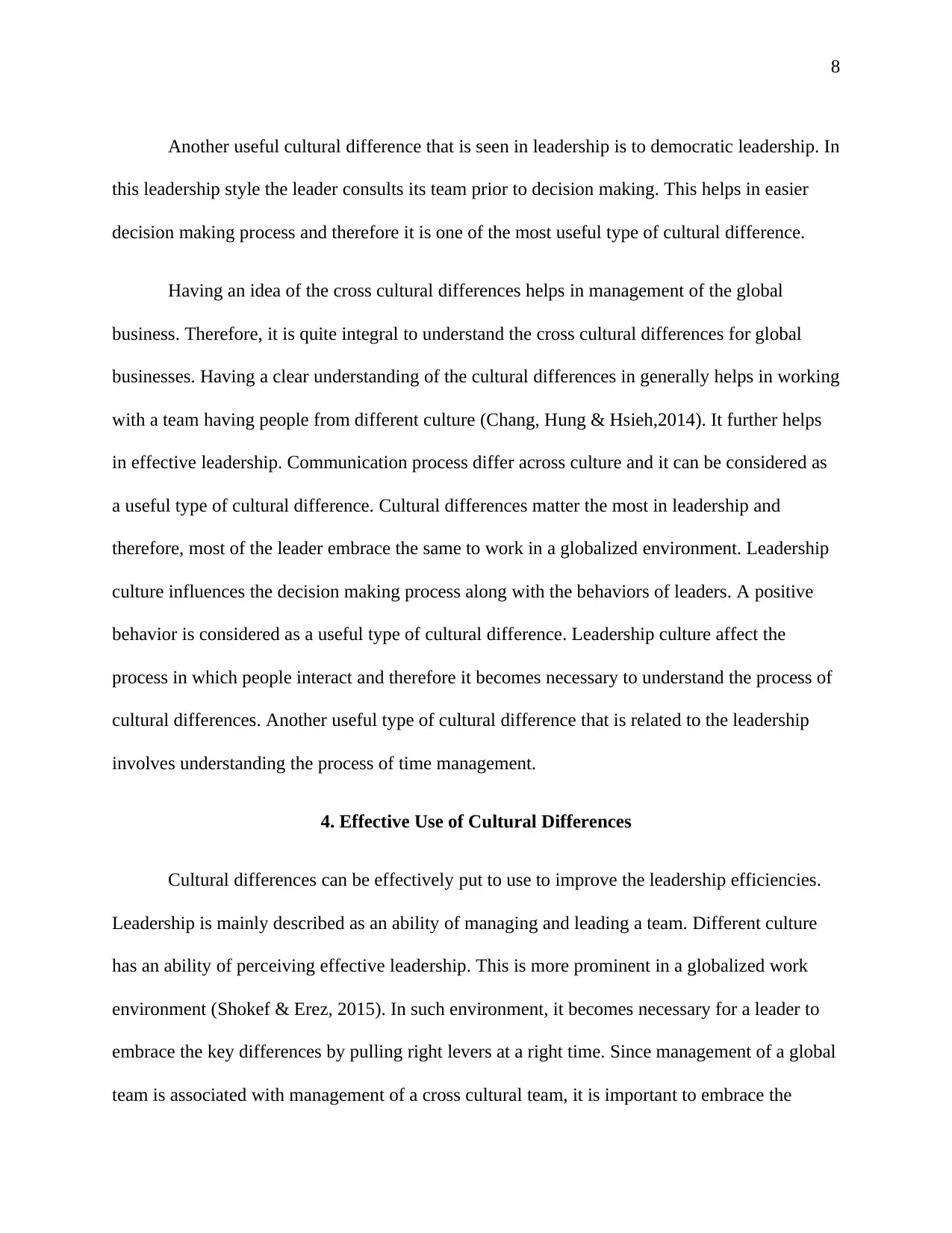
8
Another useful cultural difference that is seen in leadership is to democratic leadership. In
this leadership style the leader consults its team prior to decision making. This helps in easier
decision making process and therefore it is one of the most useful type of cultural difference.
Having an idea of the cross cultural differences helps in management of the global
business. Therefore, it is quite integral to understand the cross cultural differences for global
businesses. Having a clear understanding of the cultural differences in generally helps in working
with a team having people from different culture (Chang, Hung & Hsieh,2014). It further helps
in effective leadership. Communication process differ across culture and it can be considered as
a useful type of cultural difference. Cultural differences matter the most in leadership and
therefore, most of the leader embrace the same to work in a globalized environment. Leadership
culture influences the decision making process along with the behaviors of leaders. A positive
behavior is considered as a useful type of cultural difference. Leadership culture affect the
process in which people interact and therefore it becomes necessary to understand the process of
cultural differences. Another useful type of cultural difference that is related to the leadership
involves understanding the process of time management.
4. Effective Use of Cultural Differences
Cultural differences can be effectively put to use to improve the leadership efficiencies.
Leadership is mainly described as an ability of managing and leading a team. Different culture
has an ability of perceiving effective leadership. This is more prominent in a globalized work
environment (Shokef & Erez, 2015). In such environment, it becomes necessary for a leader to
embrace the key differences by pulling right levers at a right time. Since management of a global
team is associated with management of a cross cultural team, it is important to embrace the
Another useful cultural difference that is seen in leadership is to democratic leadership. In
this leadership style the leader consults its team prior to decision making. This helps in easier
decision making process and therefore it is one of the most useful type of cultural difference.
Having an idea of the cross cultural differences helps in management of the global
business. Therefore, it is quite integral to understand the cross cultural differences for global
businesses. Having a clear understanding of the cultural differences in generally helps in working
with a team having people from different culture (Chang, Hung & Hsieh,2014). It further helps
in effective leadership. Communication process differ across culture and it can be considered as
a useful type of cultural difference. Cultural differences matter the most in leadership and
therefore, most of the leader embrace the same to work in a globalized environment. Leadership
culture influences the decision making process along with the behaviors of leaders. A positive
behavior is considered as a useful type of cultural difference. Leadership culture affect the
process in which people interact and therefore it becomes necessary to understand the process of
cultural differences. Another useful type of cultural difference that is related to the leadership
involves understanding the process of time management.
4. Effective Use of Cultural Differences
Cultural differences can be effectively put to use to improve the leadership efficiencies.
Leadership is mainly described as an ability of managing and leading a team. Different culture
has an ability of perceiving effective leadership. This is more prominent in a globalized work
environment (Shokef & Erez, 2015). In such environment, it becomes necessary for a leader to
embrace the key differences by pulling right levers at a right time. Since management of a global
team is associated with management of a cross cultural team, it is important to embrace the
⊘ This is a preview!⊘
Do you want full access?
Subscribe today to unlock all pages.

Trusted by 1+ million students worldwide

9
cultural differences and differences in origin of the team members. The role of an effective
leader in this case is quite integral. There are some notable and consistent differences in the style
of leadership. Effectiveness of cross cultural leadership is dependent on the combination of
approaches. Professional development in cross cultural leadership mainly depends on three
pillars, which include knowledge, self-awareness and application (Presbitero & Toledano, 2018).
Since a cross cultural team involves human resources across culture, it is possible to develop
knowledge across the cultural dimension and put that knowledge to use while working on a
project. If a leader is able to understand the dynamics of a diverse group and team, it is possible
to yield a better result.
Another effective use of cultural differences in team is that it helps in development of
new skills in cross cultural communication. Effective communication across the people of
different culture mainly helps in setting clear expectations and goal within the team, which helps
in easier task delivery (Scott & Wildman, 2015). The cross cultural leadership further helps in
development and implementation of specific business practices and tools, which is another
effective use of cultural differences across team. Therefore, it can be said that presence of a
culturally diverse team can provide numerous benefit to an existing business process. Therefore,
it is quite integral to know the key importance of cross cultural differences in a global business
context.
Cultural difference in a global team is a common and sensitive issue. The leader who
takes time in understanding the cultural differences generally has a better change of remaining
successful and competitive in an international business environment.
5. Importance of understanding Cross Cultural Differences of Global Business
cultural differences and differences in origin of the team members. The role of an effective
leader in this case is quite integral. There are some notable and consistent differences in the style
of leadership. Effectiveness of cross cultural leadership is dependent on the combination of
approaches. Professional development in cross cultural leadership mainly depends on three
pillars, which include knowledge, self-awareness and application (Presbitero & Toledano, 2018).
Since a cross cultural team involves human resources across culture, it is possible to develop
knowledge across the cultural dimension and put that knowledge to use while working on a
project. If a leader is able to understand the dynamics of a diverse group and team, it is possible
to yield a better result.
Another effective use of cultural differences in team is that it helps in development of
new skills in cross cultural communication. Effective communication across the people of
different culture mainly helps in setting clear expectations and goal within the team, which helps
in easier task delivery (Scott & Wildman, 2015). The cross cultural leadership further helps in
development and implementation of specific business practices and tools, which is another
effective use of cultural differences across team. Therefore, it can be said that presence of a
culturally diverse team can provide numerous benefit to an existing business process. Therefore,
it is quite integral to know the key importance of cross cultural differences in a global business
context.
Cultural difference in a global team is a common and sensitive issue. The leader who
takes time in understanding the cultural differences generally has a better change of remaining
successful and competitive in an international business environment.
5. Importance of understanding Cross Cultural Differences of Global Business
Paraphrase This Document
Need a fresh take? Get an instant paraphrase of this document with our AI Paraphraser
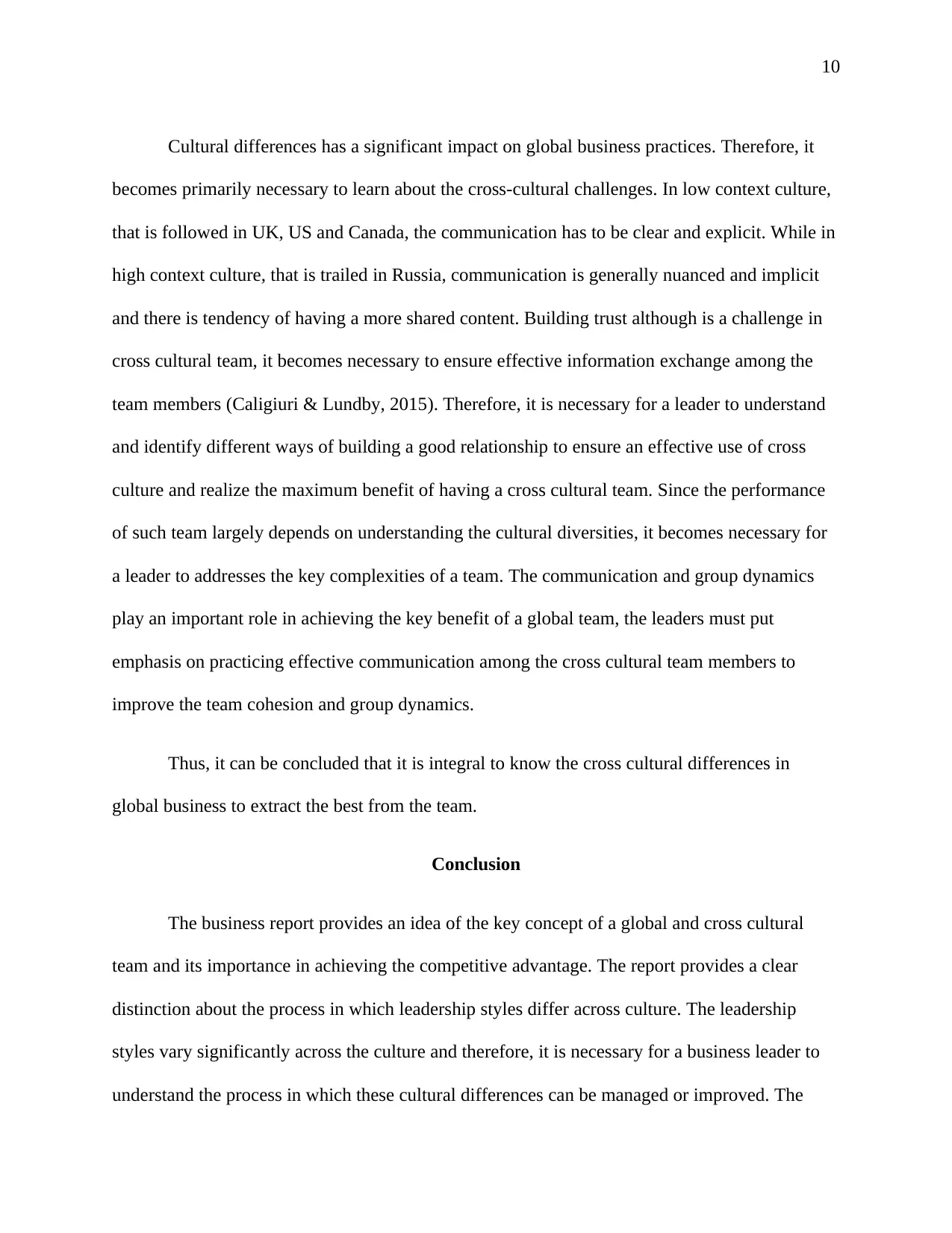
10
Cultural differences has a significant impact on global business practices. Therefore, it
becomes primarily necessary to learn about the cross-cultural challenges. In low context culture,
that is followed in UK, US and Canada, the communication has to be clear and explicit. While in
high context culture, that is trailed in Russia, communication is generally nuanced and implicit
and there is tendency of having a more shared content. Building trust although is a challenge in
cross cultural team, it becomes necessary to ensure effective information exchange among the
team members (Caligiuri & Lundby, 2015). Therefore, it is necessary for a leader to understand
and identify different ways of building a good relationship to ensure an effective use of cross
culture and realize the maximum benefit of having a cross cultural team. Since the performance
of such team largely depends on understanding the cultural diversities, it becomes necessary for
a leader to addresses the key complexities of a team. The communication and group dynamics
play an important role in achieving the key benefit of a global team, the leaders must put
emphasis on practicing effective communication among the cross cultural team members to
improve the team cohesion and group dynamics.
Thus, it can be concluded that it is integral to know the cross cultural differences in
global business to extract the best from the team.
Conclusion
The business report provides an idea of the key concept of a global and cross cultural
team and its importance in achieving the competitive advantage. The report provides a clear
distinction about the process in which leadership styles differ across culture. The leadership
styles vary significantly across the culture and therefore, it is necessary for a business leader to
understand the process in which these cultural differences can be managed or improved. The
Cultural differences has a significant impact on global business practices. Therefore, it
becomes primarily necessary to learn about the cross-cultural challenges. In low context culture,
that is followed in UK, US and Canada, the communication has to be clear and explicit. While in
high context culture, that is trailed in Russia, communication is generally nuanced and implicit
and there is tendency of having a more shared content. Building trust although is a challenge in
cross cultural team, it becomes necessary to ensure effective information exchange among the
team members (Caligiuri & Lundby, 2015). Therefore, it is necessary for a leader to understand
and identify different ways of building a good relationship to ensure an effective use of cross
culture and realize the maximum benefit of having a cross cultural team. Since the performance
of such team largely depends on understanding the cultural diversities, it becomes necessary for
a leader to addresses the key complexities of a team. The communication and group dynamics
play an important role in achieving the key benefit of a global team, the leaders must put
emphasis on practicing effective communication among the cross cultural team members to
improve the team cohesion and group dynamics.
Thus, it can be concluded that it is integral to know the cross cultural differences in
global business to extract the best from the team.
Conclusion
The business report provides an idea of the key concept of a global and cross cultural
team and its importance in achieving the competitive advantage. The report provides a clear
distinction about the process in which leadership styles differ across culture. The leadership
styles vary significantly across the culture and therefore, it is necessary for a business leader to
understand the process in which these cultural differences can be managed or improved. The

11
report further provides an idea of the benefits that a business can achieve with the existence of a
cross cultural team. It is important to understand the benefits that can be realized with the
presence of a cross cultural team to ensure business competitive advantage. The report provides
an idea of the process in which maximum benefit can be realized from a culturally different
team. In short, the report documents the ways in which cultural leadership differs across culture.
Recommendations
In basis of the findings of the report, certain key recommendations related to
understanding the importance of cross cultural differences can be made. The recommendations
are indicated as follows-
1. Communication is the key to achieve maximum benefit of a cross cultural team and
therefore, effective communication among the team is recommended
2. It is recommended for a leader to know the skills of leveraging the power of culture by
trying to understand the dynamics of the global team members.
report further provides an idea of the benefits that a business can achieve with the existence of a
cross cultural team. It is important to understand the benefits that can be realized with the
presence of a cross cultural team to ensure business competitive advantage. The report provides
an idea of the process in which maximum benefit can be realized from a culturally different
team. In short, the report documents the ways in which cultural leadership differs across culture.
Recommendations
In basis of the findings of the report, certain key recommendations related to
understanding the importance of cross cultural differences can be made. The recommendations
are indicated as follows-
1. Communication is the key to achieve maximum benefit of a cross cultural team and
therefore, effective communication among the team is recommended
2. It is recommended for a leader to know the skills of leveraging the power of culture by
trying to understand the dynamics of the global team members.
⊘ This is a preview!⊘
Do you want full access?
Subscribe today to unlock all pages.

Trusted by 1+ million students worldwide
1 out of 16
Related Documents
Your All-in-One AI-Powered Toolkit for Academic Success.
+13062052269
info@desklib.com
Available 24*7 on WhatsApp / Email
![[object Object]](/_next/static/media/star-bottom.7253800d.svg)
Unlock your academic potential
Copyright © 2020–2025 A2Z Services. All Rights Reserved. Developed and managed by ZUCOL.





